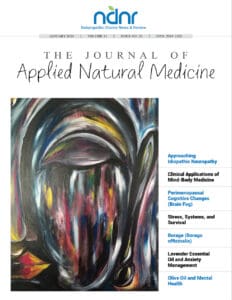A Clinical Roundup of New Recommendations for Anticipatory Guidance
Setareh Tais, ND
Deborah Gleisner, ND
Well-child care is an integral aspect of primary care for the pediatric population. The American Academy of Pediatrics and the Bright Futures promotion suggest myriad screening recommendations and topics to be discussed at each well-child visit, with the goals of promoting health, detecting illness, and counseling parents on preventing future illnesses.1 The well-child visit consists of the following 5 components: history taking, physical examination, screening, immunization, and anticipatory guidance.
The schedule for preventive care visits for infants and toddlers is closely tied to the immunization schedule set forth by the Centers for Disease Control and Prevention. A recent survey found that what parents value the most during their well-child visit is the opportunity to obtain individualized information from their pediatrician, to gain reassurance that their child is growing and developing well, and to be reassured about their parenting skills.2 Parents who choose naturopathic care for their children instead of allopathic pediatric care are motivated by a desire for a more holistic approach, wanting more time and attention from their child’s pediatrician, as well as opting for an alternative vaccination schedule.3-6 With prevention being a key principle in naturopathic medicine, NDs are well positioned to provide thorough counseling on health promotion, guidance in preventing future illnesses, and thoughtful discussion about concerns regarding immunizations.
In an attempt to broaden and update our knowledge of preventive healthcare for the pediatric population, we conducted interviews with various experts across the country. We asked them to expand on some of the new recommendations for anticipatory guidance during well-child visits. The forthcoming interviews cover just some of the important topics to be addressed during pediatric preventive care visits.
Renee, how can you tell if a breastfed baby is getting enough milk at the breast?
First, remember that input (milk) is equivalent to output (dirty and wet diapers). In the first day of life, baby should have at least 1 wet or soiled diaper. On day 2, baby should have 2 wet or soiled diapers. This should continue increasing by 1 for each day of life. Once the mother’s milk is in, baby should have 6 to 8 wet or soiled diapers every 24 hours. This pattern is different after the first 2 weeks of life. At that point, a breastfed baby can go up to 10 days without a bowel movement, as long as he or she is urinating regularly. Babies are expected to lose up to 10% of their birth weight in the first few days, regaining their birth weight by 2 weeks of age. Normal newborn weight gain is 4 to 7 oz in 1 week, once the colostrum has transitioned to mature milk.
At what point do you suggest supplementation?
When baby has lost more than 10% of birth weight or if baby is not back to birth weight by 2 weeks, supplementation may be necessary. If mother is unable to put baby to breast efficiently or effectively, she may need support from a trained lactation consultant with IBCLC [International Board of Lactation Consultant Examiners] credentials. They can help determine if breastfeeding support is all that is needed or if supplementation is truly necessary.
Renee Sicignano, LM, CPM, LC, Santa Clarita Birthing Center, Newhall, California
Dr Berg, what are your recommendations for the use of fluoridated toothpaste in infants and young children?
The American Dental Association has recently clarified the safe quantity of fluoride to prevent caries. If the appropriate amount of fluoridated toothpaste is used, the risk of fluorosis is low, while still providing protection against caries. In counseling parents, I reference the legume family. A lentil-size smear of fluoridated toothpaste twice a day is safe and appropriate for children 6 months to age 3 years old. For a 3- to 6-year-old, use a pea-size smear of fluoridated toothpaste twice a day, an edamame-size smear twice a day for ages 6 to 12 years old, and a lima bean–size smear for kids age 12 and up.7,8
There seem to be various recommendations for the timing of the first dentist appointment. When should a child have his or her first dentist visit, and what does this visit entail?
The first visit should be no later than the first birthday. The first visit is very important for providing anticipatory guidance on caries prevention and to identify high-risk patients for more rigorous methods of preventing caries. There are 3 main areas that are addressed during this first visit in an effort to prevent dental caries. The first and most important is addressing the diet, specifically the frequency that fermentable carbohydrates like milk are ingested. What most parents don’t understand is that it’s not the amount of milk that is consumed but rather the frequency of milk ingestion that corresponds with risk for developing caries. So, for example, a teenager that sips on a can of Mountain Dew throughout the day has a higher risk of developing dental caries than the teenager that drinks 5 cans of Mountain Dew during a meal (although I wouldn’t recommend that for other reasons). For breastfed babies, who nurse more frequently than formula-fed babies, we encourage the parents to wipe their baby’s teeth after each feeding. The second part of the dental visit focuses on hygiene. That’s when I show parents the proper way to brush their infant’s teeth, and I observe them brush their infant’s teeth to ensure it’s done correctly to maximize protection against caries. The third part of the dental visit is assessing the baby’s exposure to fluoride and discussing the use of fluoridated toothpaste.
Joel Berg, DDS, MS, Department of Dentistry, Seattle Children’s Hospital, Seattle, Washington
Dr Pisharody, based on current evidence, when is the ideal time to introduce foods to an infant with a family history of food allergies?
Based upon the most current guidelines from the American Academy of Pediatrics, the ideal time to introduce solid foods to an infant, even one with a family history of food allergies, is between the age of 4 and 6 months. There is no proven basis to delay introduction of even potential allergenic foods (such as milk, egg, or peanut) to these infants.9,10
How do you reconcile the difference between the AAP and the WHO recommendations for exclusively breastfeeding infants?
Both the American Academy of Pediatrics (AAP) and the World Health Organization (WHO) advocate breastfeeding for at least the first 6 months of an infant’s life. Whereas the WHO recommends waiting until after 6 months of age to introduce solid foods, the AAP states that solids may be introduced between 4 and 6 months of age.
As a means of food allergy prevention, the AAP recommends that solid foods should not be introduced before 4 to 6 months of age but, at the same time, not delayed beyond this time either. I reconcile the differences between the AAP and the WHO recommendations knowing that the WHO is primarily addressing the needs of children worldwide, where food allergy is probably a minor concern when compared to risk of morbidity and mortality from malnutrition and infectious diseases.
In terms of introducing solid foods to infants purely as a strategy to reduce the risk of potential food allergies later in life, there seems to be a “window” of opportunity between 4 and 6 months of age, and this is what is reflected in the AAP’s guidelines for introducing solids between 4 and 6 months of age.
Uma Pisharody, MD, Pediatric Gastroenterology, Swedish Medical Center, Seattle, Washington
Dr Fernald, how can we counsel parents on enriching the early language experience during well-child visits?
Parents are often unaware of how important it is to provide linguistic nourishment to their child. Language nutrition and language exercise are very important for language growth. Reading storybooks exposes the child to a richer vocabulary and helps them connect words to images. But the most important thing for enriching the early language experience is narrating daily ordinary activities. So, parents should be encouraged to turn off videos and just talk about what they are doing, what they will do next, and what they see around them.11-13
The normal vocabulary for a 2-year-old is 50 to 200 words. Do you have any recommendations for pediatricians if a toddler presents to his or her 2-year well-child visit and is just barely using 50 words?
There is a big range of normal vocabulary at that age. A 2-year-old who is not reaching vocabulary milestones can potentially be just a late talker. In our research, we evaluate language comprehension in toddlers who aren’t talking as much. A toddler who doesn’t have many words but can understand the meaning of words is more likely to be a late talker. Having said that, children who aren’t receiving linguistic nutrition are much slower to talk. In these instances, parents should be encouraged to constantly talk through daily activities.
Is there any evidence that teaching babies sign language will enrich their language?
Initially, the claim was that signing could help an infant reach his or her language milestones sooner. There is no scientific evidence that teaching infants sign language has any effect on spoken language. However, parents who sign with their babies report how pleasurable and fun it is. It is very rewarding for parents to be able to communicate with their infant in this manner, and it seems to help strengthen the bonding experience and contribute to attachment.
Anne Fernald, PhD, Center for Infant Studies, Stanford University, Stanford, California
Dr Christakis, what do the latest studies says about screen time in infants and toddlers?
The latest studies for children under the age of 2 years suggest that screen time has no educational benefit whatsoever. In fact, studies have shown that screen time in children under the age of 2 years can be harmful by contributing to language delay, shorter attention span, and delayed school readiness. This is particularly true of media like Baby Einstein [The Baby Einstein Company, LLC, Glendale, California] and Brainy Baby [The Brainy Company, Suwanee, Georgia] that are geared towards infants; these videos are more rapidly paced to engage babies, which can negatively affect their attention span later in life.14,15
How can parents find age-appropriate media for their children?
The good news is that, for children over the age of 2 years, there is good programming that can improve kindergarten readiness and social development. Parents should choose high-quality educational programs. Parents should watch these programs with their children and discuss the topic and educational points. CommonSenseMedia.org [Common Sense Media Inc, San Francisco, California] is a terrific resource that reviews and rates television programs, movies, books, and computer games for children.
Dimitri Christakis, MD, MPH, Center for Child Health, Behavior and Development, Seattle Children’s Research Institute, Seattle, Washington
Dr Zwickey, recently the AAP has issued statements on vitamin D and iron supplementations in infants and toddlers. Are there any other supplements that should be recommended, such as probiotic supplementation in children with atopic conditions?
First, we have to stop thinking of probiotics in generic terms. Different strains of microbes have different therapeutic effects. In terms of atopic eczema, the evidence is building for strains of Lactobacillus rhamnosus and Bifidobacterium when administered directly to children16,17 or when administered to pregnant women.18 These microbes may be more effective in driving a T-regulatory response (Treg).19 In contrast, Lactobacillus strain GG is not effective in preventing atopic eczema when given to pregnant women,20 but Lactobacillus acidophilus L-92 was effective in treating children directly. This strain of microbe may drive a TH1 [helper T cell, subtype 1] response rather than a TH3 response.21 Overall, it’s clear that microbes can influence diseases that are immunologically mediated. However, much more research must be done before we know which microbes are ideal for each situation.
Parents seeking naturopathic care for their children often ask to delay immunizations for a few months or until baby transitions to daycare or preschool. What are your thoughts on delaying immunizations in infants with minimal risk factors?
My concern with vaccination is that we administer too many vaccines too early in the immunological development of a child. Children who are under a year of age are unable to develop TH1 immune responses to vaccines and instead develop TH2 responses, which are associated with allergy and asthma.22,23 A recent Canadian study24 suggests that delaying vaccination by 2 months reduces the incidence of asthma. This suggests that delaying vaccination until children can mount an appropriate immune response may not only reduce the incidence of allergies and asthma but may also increase immunological memory to the vaccines, making them more effective.
Heather Zwickey, PhD, Immunology and Helfgott Research Institute, National College of Natural Medicine, Portland, Oregon
Dr Offit, how would you ease the minds of worried parents about the MMR [measles-mumps-rubella] vaccine causing autism?
It is always perfectly reasonable to ask questions about vaccine safety. Parents are often worried that the MMR vaccine has caused a change in their child’s behavior, but the best way to answer these kinds of questions is to study trends seen in thousands of kids. More than 14 different studies across several continents followed thousands of kids who received the MMR vaccine; no causal link was found. The question of the MMR-autism link has been answered.25-32
Many parents often inquire about the long-term side effects of vaccine adjuvants, such as aluminum, as well as additives like polysorbate 80 and formaldehyde. What are the long-term effects of these ingredients, and should parents be worried about them?
Well, let’s talk about each of these separately. Aluminum salts have been used as adjuvants in vaccines for over 70 years. They are a light metal, found in everything we are exposed to, including drinking water and baby formula. The body can handle small doses of aluminum and can clear it well. Formaldehyde is a single carbon metabolite that is used to inactivate live vaccines like polio and pertussis. It has a bad connotation because large quantities of it are used for preserving cadavers, but the actual dose in the vaccine is small compared to what is naturally occurring in our bodies. The same goes for polysorbate 80; there are trace doses in things we are commonly exposed to every day. With each of these ingredients, I like to cite Paracelsus, when he said, “The dose makes the poison.”
Parents commonly express their desire to delay the hepatitis B vaccination until the age of sexual maturity. Isn’t it reasonable to delay this vaccine until the risk factors for hepatitis B exposure are higher?
Prior to the hepatitis B vaccination, 16 000 kids under the age of 10 were diagnosed with hepatitis B per year. Half of them were exposed during childbirth, and the other half got it from causal contact with someone who has hepatitis B, not from sex, tattoos, or IV [intravenous] drug use. The notion that hepatitis B is only transmitted through sex, IV drug use, or tattooing is incorrect, and the vaccine has helped dramatically reduce the incidence of hepatitis B in children.
Paul Offit, MD, Department of Pediatrics and Vaccine Education Center at The Children’s Hospital of Philadelphia, University of Pennsylvania, Philadelphia
Acknowledgment
We would like to thank everyone who participated in this clinical roundup for taking the time to share their valuable expertise.
Setareh Tais, ND received her doctor of naturopathic medicine degree from Bastyr University, Seattle, Washington, in 2009. She is currently in her second year of residency at a family medicine clinic in Marysville, Washington, where she sees a diverse patient population and has been working on various clinical research projects. She can be reached at stais@ncoh.net.
Deborah, Gleisner ND, LM received her doctor of naturopathic medicine and midwifery degrees from Bastyr University in 2009. She has a private practice in West Hollywood, California, where she works with women and babies at all ages of life. Her Web site is www.DeborahGleisnerND.com, and she can be reached at deborahgleisner@gmail.com.
References
1. Hagan JF, Shaw JS, Duncan PM, et al. Bright Futures: Guidelines for Health Supervision of Infants, Children, and Adolescents. 3rd ed. Elk Grove Village, IL: American Academy of Pediatrics; 2008.
2. Radecki L, Olson LM, Frintner MP, Tanner JL, Stein MT. What do families want from well-child care? including parents in the rethinking discussion. Pediatrics. 2009;124:858-865.
3. Leung B, Verhoef M. Survey of parents on the use of naturopathic medicine in children: characteristics and reasons. Complement Ther Clin Pract. 2008;14(2):98-104.
4. Fleming SA, Gutknecht NC. Naturopathy and the primary care practice. Prim Care. 2010;37(1):119-136.
5. Bellas A, Lafferty WE, Lind B, Tyree PT. Frequency, predictors and expenditures for pediatric insurance claims for complementary and alternative medical professionals in Washington state. Arch Pediatr Adolesc Med. 2005;159:367-372.
6. Downey L, Tyree PT, Huebner CE, Lafferty WE. Pediatric vaccination and vaccine-preventable disease acquisition: associations with care by complementary and alternative medicine providers. Matern Child Health J. 2010;14(6):922-930.
7. Adair SM. Evidence-based use of fluoride in contemporary pediatric dental practice. Pediatr Dent. 2006;28(2):133-142.
8. American Academy of Pediatric Dentistry. Policy on the dental home. Pediatr Dent. 2007;29(suppl):22-23.
9. Boyce JA, Assa’ad A, Burks AW, et al; NIAID-Sponsored Expert Panel. Guidelines for the diagnosis and management of food allergy in the United States: report of the NIAID-Sponsored Expert Panel. J Allergy Clin Immunol. 2010;126(6)(suppl):S1-S58.
10. Greer FR, Sicherer SH, Burks W; Committee on Nutrition and Section on Allergy and Immunology. Effects of early nutritional interventions on the development of atopic disease in infants and children: the role of maternal dietary restriction, breastfeeding, timing of introduction of complementary foods, and hydrolyzed formulas. Pediatrics. 2008;121:183-191.
11. Hurtado N, Marchman VA, Fernald A. Does input influence uptake? links between maternal talk, processing speed and vocabulary size in Spanish-learning children. Dev Sci. 2008;11(6):F31-F39.
12. Fernald A, Marchman VA. Language learning in infancy. In: Traxler MJ, Gernsbacher MA, eds. Handbook of Psycholinguistics. 2nd ed. Burlington, MA: Academic Press; 2006.
13. Fernald A, Perfors A, Marchman VA. Picking up speed in understanding: speech processing efficiency and vocabulary growth across the second year. Dev Psychol. 2006;42:98-116.
14. Christakis DA. Infant media viewing: first, do no harm. Pediatr Ann. 2010;39(9):578-582.
15. Christakis DA, Zimmerman FJ. The Elephant in the Living Room: Make Television Work for Your Kids. New York, NY: Rodale; 2006.
16. Gerasimov SV, Vasjuta VV, Myhovych OO, Bondarchuk LI. Probiotic supplement reduces atopic dermatitis in preschool children: a randomized, double-blind, placebo-controlled, clinical trial. Am J Clin Dermatol. 2010;11:351-361.
17. Wickens K, Black PN, Stanley TV, et al. A differential effect of 2 probiotics in the prevention of eczema and atopy: a double-blind, randomized, placebo-controlled trial. J Allergy Clin Immunol. 2008;122:788-794.
18. Kim K, Zakharkin SO, Allison DB. Expectations, validity, and reality in gene expression profiling. J Clin Epidemiol. 2010;63:950-959.
19. Koyama T, Kirjavainen PV, Fisher C, et al. Development and pilot evaluation of a novel probiotic mixture for the management of seasonal allergic rhinitis. Can J Microbiol. 2010;56:730-738.
20. Boyle RJ, Ismail IH, Kivivuori S, et al. Lactobacillus GG treatment during pregnancy for the prevention of eczema: a randomized controlled trial. Allergy. 2011;66(4):509-516.
21. Torii S, Torii A, Itoh K, et al. Effects of oral administration of Lactobacillus acidophilus L-92 on the symptoms and serum markers of atopic dermatitis in children. Int Arch Allergy Immunol. 2011;154:236-245.
22. Siegrist CA. Neonatal and early life vaccinology. Vaccine. 2001;19:3331-3346.
23. Levy O. Innate immunity of the human newborn: distinct cytokine responses to LPS and other Toll-like receptor agonists. J Endotoxin Res. 2005;11(2):113-116.
24. McDonald KL, Huq SI, Lix LM, Becker AB, Kozyrskyj AL. Delay in diphtheria, pertussis, tetanus vaccination is associated with a reduced risk of childhood asthma. J Allergy Clin Immunol. 2008;121(3):626-631.
25. Verstraeten T, Davis RL, DeStefano F, et al; Vaccine Safety Datalink Team. Safety of thimerosal-containing vaccines: a two-phased study of computerized health maintenance organization databases [published correction appears in Pediatrics. 2004;113(1):184]. Pediatrics. 2003;112(5):1039-1048.
26. Madsen KM, Lauritsen MB, Pedersen CB, et al. Thimerosal and the occurrence of autism: negative ecological evidence from Danish population-based data. Pediatrics. 2003;112:604-606.
27. Stehr-Green P, Tull P, Stellfeld M, Mortenson PB. Simpson D. Autism and thimerosal-containing vaccines: lack of consistent evidence for an association. Am J Prev Med. 2003;25:101-106.
28. Hornig M, Briese T, Buie T, et al. Lack of association between measles virus vaccine and autism with enteropathy: a case-control study. PLoS One. 2008;3(9):e3140. http://www.ncbi.nlm.nih.gov/pmc/articles/PMC2526159/?tool=pubmed. Accessed July 26, 2011.
29. Deer B. How the case against the MMR vaccine was fixed. BMJ. 2011;342:c5347. http://www.bmj.com/content/342/bmj.c5347.long. Accessed July 26, 2011.
30. Brauser D. Autism and MMR vaccine study an ‘elaborate fraud,’ charges BMJ. Medscape Med News. January 6, 2011. http://www.medscape.com/viewarticle/735354. Accessed July 26, 2011.
31. DeStefano F. Vaccines and autism: evidence does not support a causal association. Clin Pharmacol Ther. 2007;82(6):756-759.
32. Gerber JS, Offit PA. Vaccines and autism: a tale of shifting hypotheses. Clin Infect Dis. 2009;48(4):456-461.




